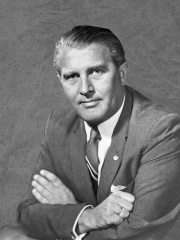
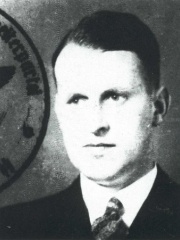
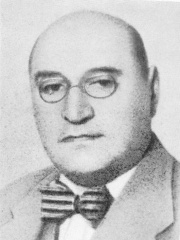
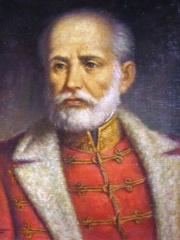
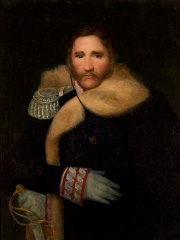
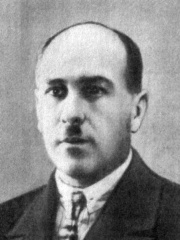

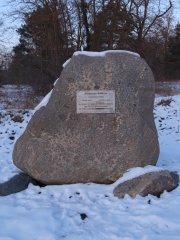
The Most Famous
ENGINEERS from Poland
Top 10
The following people are considered by Pantheon to be the top 10 most legendary Polish Engineers of all time. This list of famous Polish Engineers is sorted by HPI (Historical Popularity Index), a metric that aggregates information on a biography’s online popularity. Visit the rankings page to view the entire list of Polish Engineers.

1. Wernher von Braun (1912 - 1977)
With an HPI of 73.69, Wernher von Braun is the most famous Polish Engineer. His biography has been translated into 85 different languages on wikipedia.
Wernher Magnus Maximilian Freiherr von Braun (US: VUR-nər von BROWN, German: [ˌvɛʁnheːɐ̯ fɔn ˈbʁaʊ̯n]; 23 March 1912 – 16 June 1977) was a German-American aerospace engineer and space architect. He was a member of the Nazi Party and Allgemeine SS, the leading figure in the development of rocket technology in Nazi Germany, and later a pioneer of rocket and space technology in the United States.As a young man, von Braun worked in Nazi Germany's rocket development program. He helped design and co-developed the V-2 rocket at Peenemünde during World War II. The V-2 became the first artificial object to travel into space on 20 June 1944. Following the war, he was secretly moved to the United States, along with about 1,600 other German scientists, engineers, and technicians, as part of Operation Paperclip. He worked for the United States Army on an intermediate-range ballistic missile program, and he developed the rockets that launched the United States' first space satellite Explorer 1 in 1958. He worked with Walt Disney on a series of films, which popularized the idea of human space travel in the U.S. and beyond from 1955 to 1957.In 1960, his group was assimilated into NASA, where he served as director of the newly formed Marshall Space Flight Center and as the chief architect of the Saturn V super heavy-lift launch vehicle that propelled the Apollo spacecraft to the Moon. In 1967, von Braun was inducted into the National Academy of Engineering, and in 1975, he received the National Medal of Science. Von Braun is a highly controversial figure widely seen as escaping justice for his Nazi war crimes due to the Americans' desire to beat the Soviets in the Cold War. He is also sometimes described by others as the "father of space travel", the "father of rocket science", or the "father of the American lunar program". He advocated a human mission to Mars.

2. Hans Kammler (1901 - 1945)
With an HPI of 60.06, Hans Kammler is the 2nd most famous Polish Engineer. His biography has been translated into 22 different languages.
Hans Kammler (26 August 1901 – 1945 [assumed]) was an SS-Obergruppenführer responsible for Nazi civil engineering projects and its top secret V-weapons program. He oversaw the construction of various Nazi concentration camps before being put in charge of the V-2 rocket and Emergency Fighter Programs towards the end of World War II. Kammler disappeared in May 1945 during the final days of the war. There has been much conjecture regarding his fate.

3. Adam Czerniaków (1880 - 1942)
With an HPI of 59.50, Adam Czerniaków is the 3rd most famous Polish Engineer. His biography has been translated into 23 different languages.
Adam Czerniaków (30 November 1880 – 23 July 1942) was a Polish engineer and senator who was head of the Warsaw Ghetto Jewish Council (Judenrat) during World War II. He committed suicide on 23 July 1942 by swallowing a cyanide pill, a day after the commencement of mass extermination of Jews known as the Grossaktion Warsaw.

4. Józef Bem (1794 - 1850)
With an HPI of 59.08, Józef Bem is the 4th most famous Polish Engineer. His biography has been translated into 25 different languages.
Józef Zachariasz Bem (Hungarian: Bem József, Turkish: Murat Pasha; 14 March 1794 – 10 December 1850) was a Polish engineer and general, an Ottoman pasha and a national hero of Poland and Hungary, and a figure intertwined with other European patriotic movements. Like Tadeusz Kościuszko (who fought in the American War of Independence) and Jan Henryk Dąbrowski (who fought alongside Napoleon Bonaparte in Italy and in the French Invasion of Russia), Bem fought outside Poland's borders anywhere his leadership and military skills were needed.
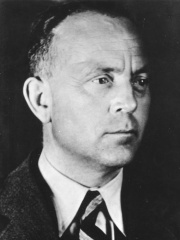
5. Kurt Tank (1898 - 1983)
With an HPI of 58.62, Kurt Tank is the 5th most famous Polish Engineer. His biography has been translated into 27 different languages.
Kurt Waldemar Tank (24 February 1898 – 5 June 1983) was a German aeronautical engineer and test pilot who led the design department at Focke-Wulf from 1931 to 1945. He was responsible for the creation of several important Luftwaffe aircraft of World War II, including the Fw 190 fighter aircraft, the Ta 152 fighter-interceptor and the Fw 200 Condor airliner. After the war, Tank spent two decades designing aircraft abroad, working first in Argentina and then in India, before returning to West Germany in the late 1960s to work as a consultant for Messerschmitt-Bölkow-Blohm (MBB).

6. Henryk Dembiński (1791 - 1864)
With an HPI of 54.07, Henryk Dembiński is the 6th most famous Polish Engineer. His biography has been translated into 17 different languages.
Henryk Dembiński (Hungarian: Dembinszky Henrik; 16 January 1791 – 13 July 1864) was a Polish engineer, traveler and general. Dembiński was born in Strzałków, Świętokrzyskie Voivodeship. In 1809 he entered the Polish army of the Duchy of Warsaw and took part in most of the Napoleonic campaigns in the East. Among others, he took part in the Battle of Leipzig in 1813. After the fall of Napoleon Bonaparte he remained in Poland and became one of the members of the Sejm of the Congress Poland.In the Polish November Uprising of 1830, he was a successful leader of the Polish forces. In 1831, after his victorious campaign in Lithuania, he was promoted to generał dywizji and for a brief period became the Polish Commander-in-Chief. He took part in the battles of Dębe Wielkie and Ostrołęka.After the fall of the revolution in 1833 he emigrated to France, where he became one of the prominent politicians of the Hôtel Lambert, a group of supporters of Adam Jerzy Czartoryski.In the Hungarian revolution of 1848 he was appointed the commanding officer of the Northern Army. After his successes he was soon promoted and Lajos Kossuth appointed him the Hungarian commander-in-chief. He was hampered by the jealousy of Artúr Görgey and after the defeat at the Battle of Kápolna, he resigned. After the Battle of Temesvár (where he was commander until the arrival of Józef Bem) and Kossuth's resignation, he fled to Turkey, where he (together with many other prominent Polish officers) entered the service of sultan Mahmud II. However, in 1850 he returned to Paris, where he died.

7. Konstantin Kalinin (1887 - 1938)
With an HPI of 50.26, Konstantin Kalinin is the 7th most famous Polish Engineer. His biography has been translated into 15 different languages.
Konstantin Alekseevich Kalinin (Russian: Калинин Константин Алексеевич; born 17 December (29) 1889 in Warsaw, Russian Empire; died 1938 or 21 April 1940 in Voronezh) was a World War I aviator and Soviet aircraft designer. He was born to a Russian family in Warsaw. Kalinin graduated from the Odessa Military School in 1912, the Gatchina Military Aviation School in 1916 and the Kyiv Polytechnic Institute in 1925. After the Treaty of Brest-Litovsk, he became a pilot and commanding officer under Ukrainian Directory Government. He was a member of the All-Union Communist Party (bolsheviks) since 1927. In 1926, he organized and headed an aviation design bureau in Kharkiv. He designed the Kalinin K-4, Kalinin K-5, Kalinin K-7 and Kalinin K-12 aircraft. Kalinin was executed in 1938 during the Stalinist purges. According to Soviet records, he died in 1940. Kalinin was one of the founders and first teachers of the Kharkiv Aviation Institute. He was awarded the Order of the Red Banner of Labour.

8. Walter Thiel (1910 - 1943)
With an HPI of 49.87, Walter Thiel is the 8th most famous Polish Engineer. His biography has been translated into 16 different languages.
Walter Thiel (3 March 1910, Breslau – 17 August 1943, Karlshagen, near Peenemünde) was a German rocket scientist. Thiel provided the decisive ideas for the A4 (V-2) rocket engine and his research enabled rockets to head towards space.

9. Johannes Winkler (1897 - 1947)
With an HPI of 49.57, Johannes Winkler is the 9th most famous Polish Engineer. His biography has been translated into 16 different languages.
Johannes Winkler (29 May 1897 – 27 December 1947) was a German rocket pioneer who co-founded with Max Valier of Opel RAK the first German rocket society "Verein für Raumschiffahrt" and launched, after Friedrich Wilhelm Sander's successful Opel RAK liquid-rocket launches in 1929, one of the first successful liquid-fuelled rocket in Europe.In 1915 during World War I, he joined the German army and was wounded in action the following year, leading to a lengthy hospitalisation. After his recovery, he studied as a machinist at the Danzig technical college and found a job at Junkers. On 5 July 1927, he was one of the founders the Verein für Raumschiffahrt (VfR – "Spaceflight Society"). He also was the society's first president and editor of the VfR's Die Rakete' journal. On 14 March 1931 at 4:45 pm, he launched the Hückel-Winkler I (HW-I) at the Gross Kühnau drill field near Dessau. According to his account, it was planned to reach an altitude of 500 meters, but it turned and flew horizontally, landing 200 meters from the pad. The maximum altitude of the rocket was not recorded. It was powered by liquid oxygen and liquid methane. Eighteen months after the HW-I flight, Winkler launched the HW-II on 6 October 1932 in a public demonstration, which included invited officials from the Königsberg council. Unfortunately, the rocket exploded within seconds of ignition because of a faulty fuel valve. Winkler designed a number of other rockets and JATO units for Junkers and then a government aviation research institute, but none left the drawing board.
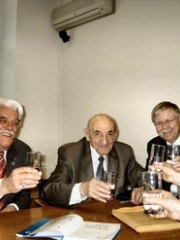
10. Boris Chertok (1912 - 2011)
With an HPI of 48.91, Boris Chertok is the 10th most famous Polish Engineer. His biography has been translated into 21 different languages.
Boris Yevseyevich Chertok (Russian: Бори́с Евсе́евич Черто́к; 14 March [O.S. 1 March] 1912 – 14 December 2011) was a Russian engineer in the former Soviet space program, mainly working in control systems, and later found employment in Roscosmos. Major responsibility under his guidance was primarily based on computerized control system of the Russian missiles and rocketry system, and authored the four-volume book Rockets and People– the definitive source of information about the history of the Soviet space program. From 1974, he was the deputy chief designer of the Korolev design bureau, the space aircraft designer bureau which he started working for in 1946. He retired in 1992.
People
Pantheon has 10 people classified as Polish engineers born between 1791 and 1912. Of these 10, none of them are still alive today. The most famous deceased Polish engineers include Wernher von Braun, Hans Kammler, and Adam Czerniaków. As of April 2024, 1 new Polish engineers have been added to Pantheon including Konstantin Kalinin.
Deceased Polish Engineers
Go to all RankingsWernher von Braun
1912 - 1977
HPI: 73.69
Hans Kammler
1901 - 1945
HPI: 60.06
Adam Czerniaków
1880 - 1942
HPI: 59.50
Józef Bem
1794 - 1850
HPI: 59.08
Kurt Tank
1898 - 1983
HPI: 58.62
Henryk Dembiński
1791 - 1864
HPI: 54.07
Konstantin Kalinin
1887 - 1938
HPI: 50.26
Walter Thiel
1910 - 1943
HPI: 49.87
Johannes Winkler
1897 - 1947
HPI: 49.57
Boris Chertok
1912 - 2011
HPI: 48.91
Newly Added Polish Engineers (2024)
Go to all RankingsOverlapping Lives
Which Engineers were alive at the same time? This visualization shows the lifespans of the 10 most globally memorable Engineers since 1700.

